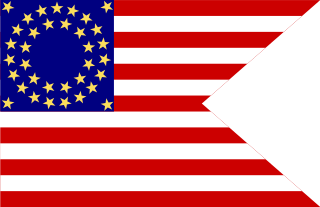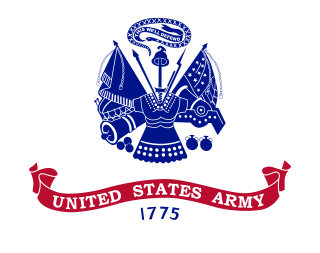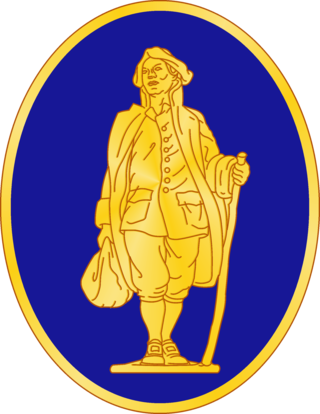
The flags of the Confederate States of America have a history of three successive designs during the American Civil War. The flags were known as the "Stars and Bars", used from 1861 to 1863; the "Stainless Banner", used from 1863 to 1865; and the "Blood-Stained Banner", used in 1865 shortly before the Confederacy's dissolution. A rejected national flag design was also used as a battle flag by the Confederate Army and featured in the "Stainless Banner" and "Blood-Stained Banner" designs. Although this design was never a national flag, it is the most commonly recognized symbol of the Confederacy.

The flag of the United States Marine Corps is the flag used to represent the U.S. Marine Corps, as well as its subsidiary units and formations.

The Civil War Campaign Medal is considered the first campaign service medal of the United States Armed Forces. The decoration was awarded to members of the United States Armed Forces who had served in the American Civil War between 1861 and 1865.
The Indian Campaign Medal is a decoration established by War Department General Orders 12, 1907. The medal was retroactively awarded to any soldier of the U.S. Army who had participated in the American Indian Wars against the Native Americans between 1865 and 1891.
The American Campaign Medal is a military award of the United States Armed Forces which was first created on November 6, 1942, by Executive Order 9265 issued by President Franklin D. Roosevelt. The medal was intended to recognize those military members who had performed military service in the American Theater of Operations during World War II. A similar medal, known as the American Defense Service Medal was awarded for active duty service before the United States' entry into World War II.

In military organizations, the practice of carrying colours, standards, flags, or guidons, both to act as a rallying point for troops and to mark the location of the commander, is thought to have originated in Ancient Egypt some 5,000 years ago. The Roman Empire also made battle standards, reading SPQR a part of their vast armies. It was formalized in the armies of Europe in the High Middle Ages, with standards being emblazoned with the commander's coat of arms.

Campaign streamers are decorations attached to military flags to recognize particular achievements or events of a military unit or service. Attached to the headpiece of the assigned flag, the streamer often is an inscribed ribbon with the name and date denoting participation in a particular battle, military campaign, or theater of war; the ribbon's colors are chosen accordingly and frequently match an associated campaign medal or ribbon bar. They often are physical manifestations of battle honours, though this does not mean all streamers are battle honours. They should not be confused with a tassel, which is usually purely decorative in nature.

In the United States Army, Navy, Air Force, Marine Corps and Coast Guard, a guidon is a military standard or flag that company/battery/troop or platoon-sized detachments carry to signify their unit designation and branch/corps affiliation or the title of the individual who carries it. A basic guidon can be rectangular, but sometimes has a triangular portion removed from the fly.

The flag of the United States Army displays a blue replica of the War Office Seal set on a white field. Beneath the seal is a broad scarlet scroll bearing the inscription in white letters, "United States Army". Beneath the scroll, in blue Hindu-Arabic numerals, is "1775", the year in which the Continental Army was created with the appointment of General George Washington as General of the Army. All of this is on a white background.

The flag of the United States Navy consists of the seal of the U.S. Department of the Navy in the center, above a yellow scroll inscribed "United States Navy" in dark blue letters, against a dark blue background.

The Alabama Army National Guard is a component of the United States Army and the United States National Guard. National coordination of various state National Guard units are maintained through the National Guard Bureau.
Each branch of the Confederate States armed forces had its own service dress and fatigue uniforms and regulations regarding them during the American Civil War, which lasted from April 12, 1861, until May 1865.
The 141st Infantry Regiment is an infantry regiment in the United States Army. The lineage of the 141st includes units tracing origins to the Texas Revolution, such as Company A, First Texas, 1836, and other infantry companies of the First Texas formed in the 1870s and 1880s.

The 18th Independent Battery Indiana Light Artillery, also known as Lilly's Hoosier Battery and Lilly's Battery, was a civil war regiment formed in Indiana during the American Civil War. The regiment was formed at the end of 1860 by 22-year-old Eli Lilly, an Indianapolis pharmacist. He had recruitment posters placed around the city and recruited primarily among his friends and classmates. The unit contained six 10-pounder Parrott rifles, and was manned by 150 men. The unit mustered in Indianapolis where it was drilled during 1861. Lilly was elected captain of the unit in August 1862 when the unit was deployed to join the Lightning Brigade commanded by Col. John T. Wilder.

The 111th Infantry Regiment, was originally the Pennsylvania Militia or "Associators" that fought in the American Revolution, composed of civilian males from the citizenry of Pennsylvania. It is one of several National Guard units with colonial roots and campaign credit for the War of 1812. The Pennsylvania Militia often fought in conjunction with General Washington and the Continental Army along the Delaware River. Today the idea of a Pennsylvania Militia is represented in the U.S. Army by 1st Battalion, 111th Infantry assigned to the Pennsylvania Army National Guard's 56th Stryker Brigade Combat Team, 28th Infantry Division. The regiment, founded as the Associators by Benjamin Franklin in Philadelphia, Pennsylvania on 21 November 1747, is the oldest regiment in Pennsylvania.

The 1st Battalion, 108th Field Artillery Regiment, 56th Stryker Brigade Combat Team, is the only direct support field artillery battalion in the only National Guard Stryker Brigade in the United States Army.

The 130th Infantry Regiment is an infantry regiment in the Army National Guard. It is one of several Army National Guard units with campaign credit for the War of 1812.

The 276th Engineer Battalion is an engineer battalion of the Virginia Army National Guard. Headquartered in Petersburg, Virginia, it is one of several Army National Guard units with campaign credit for the War of 1812.

The 623rd Field Artillery Regiment (Morgan's Men) is a single-battalion unit of the Kentucky Army National Guard. The unit draws its lineage from cavalry and infantry units of the Kentucky Militia formed in 1846 for service in the Mexican–American War. Its antecedents include units that served on both sides of the American Civil War as well as those that fought for the United States in the Spanish–American War, World War One and World War Two. The unit was first designated as the 623rd Field Artillery Battalion in 1947, serving under that name in the Korean War. It was part of the 138th Artillery Regiment in the 1960s before becoming the 623rd Artillery Regiment in 1969 and the 623rd Field Artillery Regiment in 1972. The unit served in the Gulf War as a self-propelled artillery unit; it is now equipped with the M142 HIMARS system.

The 17th Louisiana Infantry Regiment was a unit of volunteers recruited in Louisiana that fought in the Confederate States Army during the American Civil War. The regiment formed at Camp Moore in September 1861 and served during the war in the Western Theater of the American Civil War. The unit stayed in New Orleans until February 1862 and then moved north to Corinth, Mississippi. The regiment first saw action at Shiloh in April 1862 while serving in Patton Anderson's brigade. Afterwards, the regiment redeployed to the Vicksburg area and repelled Sherman's attack at Chickasaw Bayou that December. In 1863 the regiment took part in the Vicksburg campaign, first fighting at Port Gibson and then at the Siege of Vicksburg in William Baldwin's brigade. On July 4, 1863, the regiment was surrendered along with all other Confederate soldiers at Vicksburg. The soldiers were paroled and went home. The regiment reported to a parole camp at Shreveport, Louisiana, in January 1864. The regiment was on garrison duty in western Louisiana for the remainder of the war, before disbanding in May 1865.

















